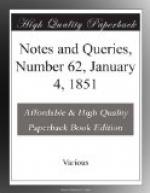The eagle being restored to the Holy Roman Empire, the lily to the Most Christian King, and the stars to the firmament, there remained for the Pope himself—an empty puff.
MARFORIO.
Portraits of Bishops.—Can any of your correspondents inform me of portraits of John Williams, archbishop of York (previously bishop of Lincoln); John Owen, bishop of St. Asaph; George Griffith, bishop of St. Asaph; Lewis Bayley, bishop of Bangor; Humphrey Henchman, bishop of London (previously bishop of Salisbury); Lord Chief Justice Glynne; and Sir Thomas Milward, chief justice of Chester.
Cassan, in his Bishops of Salisbury, mentions one of Henchman; but I mean exclusively of this.
Y.Y.
The Butcher Duke.—Can any of your readers furnish me with the rest of a Scotch song of which I have heard these two couplets?
“The Deil sat girning in a nook,
Breaking sticks to burn the duke.
A’ the Whigs sal gae to hell!
Geordie sal gae there hissel.”
And who was the writer?
MEZZOTINTO.
Rodolph Gualter.-I think I have somewhere seen it stated that Rodolph Gualter (minister at Zurich, and well known as a correspondent of our divines in the age of the Reformation) was a Scotchman. Will any of your correspondents oblige me by supplying either a reference for this statement, or a disproof of it—or both?
J.C.R.
Passage in St. Mark.—What Fathers of the early Christian Church have annotated that remarkable text, Mark xiii. 32., “[Greek: oude ho hyios],” “Neither the Son?”
As this subject has certainly engaged the attention of many of your readers, it will be a great favour conferred on the present writer, if their replies should indicate the authors’ names, the date and place of the edition, the page, and such other distinctive marks as shall lead to a prompt investigation of the subject: among them, whether the authors quoted are in the library of the British Museum.
CALMET.
“Fronte Capillata,” &c.—On the Grammar School at Guilsbro, in Northamptonshire, is inscribed the following hexameter:—
“Fronte capillata post est Occasio calva.”
I suppose it alludes to some allegorical representation of Occasio; and is intended to convey the same meaning as our English proverb, “Seize time by the forelocks.” From what author is this inscription taken?
E.H.A.
* * * * *
REPLIES.
“GOD SPEED THE PLOUGH.”
(Vol. i., p. 230.)
L.S. asks, in what rebellion was the banner carried with the motto “God speed the plough?”—(Homily against Wilful Rebellion.)
Probably in the rebellion of the Earls of Northumberland and Westmoreland in the north of England, during the autumn of A.D. 1569. In the passage of the homily which immediately follows the one quoted by L.S., occur these words:—




